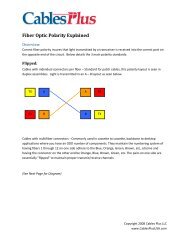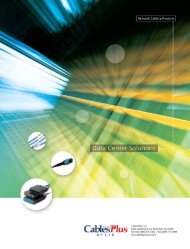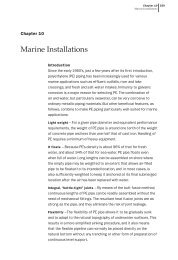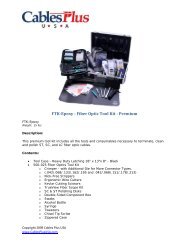Learning About Options in Fiber - Cables Plus USA
Learning About Options in Fiber - Cables Plus USA
Learning About Options in Fiber - Cables Plus USA
Create successful ePaper yourself
Turn your PDF publications into a flip-book with our unique Google optimized e-Paper software.
THE OPTICAL FIBER<br />
BASIC FIBER CONSTRUCTION<br />
SECTION 2—FIBER-OPTIC BASICS<br />
propagation is governed by the <strong>in</strong>dices of the core<br />
and cladd<strong>in</strong>g (and by Snell’s law.) Refer to section<br />
3, Glossary of Terms, for a def<strong>in</strong>ition of Snell’s Law.<br />
Optical fiber consists of a th<strong>in</strong> strand (or core) of<br />
optically pure glass surrounded by another layer<br />
of less pure glass (the cladd<strong>in</strong>g). The <strong>in</strong>ner core<br />
is the light-carry<strong>in</strong>g part. The surround<strong>in</strong>g<br />
cladd<strong>in</strong>g provides the difference <strong>in</strong> refractive<br />
<strong>in</strong>dex that allows total <strong>in</strong>ternal reflection of light<br />
through the core. The <strong>in</strong>dex of the cladd<strong>in</strong>g is less<br />
than 1 percent lower than that of the core.<br />
Most fibers have an additional coat<strong>in</strong>g around the<br />
cladd<strong>in</strong>g. This coat<strong>in</strong>g, usually one or more layers of<br />
polymer, protects the core and cladd<strong>in</strong>g from<br />
shocks that might affect their optical or physical<br />
properties. The coat<strong>in</strong>g has no optical properties<br />
affect<strong>in</strong>g the propagation of light with<strong>in</strong> the fiber.<br />
Thus the buffer coat<strong>in</strong>g serves as a shock absorber.<br />
Figure 2-1 shows the idea of light travel<strong>in</strong>g through<br />
a fiber. Light <strong>in</strong>jected <strong>in</strong>to the fiber and strik<strong>in</strong>g the<br />
core-to-cladd<strong>in</strong>g <strong>in</strong>terface at greater than the critical<br />
angle reflects back <strong>in</strong>to the core. S<strong>in</strong>ce the<br />
angles of <strong>in</strong>cidence and reflection are equal, the<br />
reflected light will aga<strong>in</strong> be reflected. The light will<br />
cont<strong>in</strong>ue zig zagg<strong>in</strong>g down the length of the fiber.<br />
Light, however, strik<strong>in</strong>g the <strong>in</strong>terface at less than<br />
the critical angle passes <strong>in</strong>to the cladd<strong>in</strong>g where it<br />
is lost over distance. The cladd<strong>in</strong>g is usually <strong>in</strong>efficient<br />
as a light carrier, and light <strong>in</strong> the cladd<strong>in</strong>g<br />
becomes attenuated fairly rapidly.<br />
Notice also <strong>in</strong> Figure 2-1 that the light is refracted<br />
as it passes from air <strong>in</strong>to the fiber. Thereafter, its<br />
The specific characteristics of light propagation<br />
through a fiber depends on many factors <strong>in</strong>clud<strong>in</strong>g:<br />
The size of the fiber; the composition of the fiber;<br />
and the light <strong>in</strong>jected <strong>in</strong>to this fiber. An understand<strong>in</strong>g<br />
of the <strong>in</strong>terplay between these properties<br />
will clarify many aspects of fiber optics.<br />
<strong>Fiber</strong> is basically classified <strong>in</strong>to three groups:<br />
• Glass (silica) which <strong>in</strong>cludes s<strong>in</strong>gle-mode step<br />
<strong>in</strong>dex fibers, multimode graded <strong>in</strong>dex, and<br />
multimode step <strong>in</strong>dex.<br />
• Plastic clad silica (PCS).<br />
• Plastic.<br />
Most optical fibers for telecommunications are<br />
made 99 percent of silica glass, the material from<br />
which quartz and sand are formed. Figure 2-1 on<br />
the previous page shows a fiber, which consists of<br />
an <strong>in</strong>ner core (about 8 to 100 micrometers, or<br />
0.0003 to 0.004 <strong>in</strong>ches, <strong>in</strong> diameter), a cladd<strong>in</strong>g<br />
(125 to 140 micrometers outer diameter) and a<br />
buffer jacket for protection.<br />
The clad is made of glass of a slightly different<br />
formula. This causes light enter<strong>in</strong>g the core at one<br />
end of the fiber to be trapped <strong>in</strong>side, a phenomenon<br />
called <strong>in</strong>ternal reflection. The light hits the<br />
boundary between the core and the cladd<strong>in</strong>g<br />
bounc<strong>in</strong>g off the cladd<strong>in</strong>g much like a billiard ball<br />
and at the same angle as it travels down the fiber.<br />
Figure 2-1—Internal Reflection <strong>in</strong> an Optical <strong>Fiber</strong><br />
Jacket<br />
Jacket<br />
Cladd<strong>in</strong>g<br />
Core<br />
Core<br />
Cladd<strong>in</strong>g<br />
Light at less than critical<br />
angle is absorbed <strong>in</strong> jacket<br />
Angle of<br />
Incidence<br />
Cladd<strong>in</strong>g<br />
Jacket<br />
Angle of<br />
Reflection<br />
Light is propagated by<br />
total <strong>in</strong>ternal reflection<br />
2-1
















